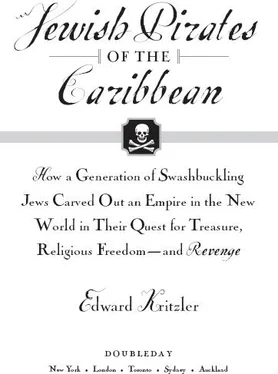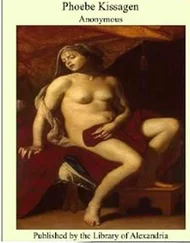Edward Kritzler - Jewish Pirates of the Caribbean
Здесь есть возможность читать онлайн «Edward Kritzler - Jewish Pirates of the Caribbean» весь текст электронной книги совершенно бесплатно (целиком полную версию без сокращений). В некоторых случаях можно слушать аудио, скачать через торрент в формате fb2 и присутствует краткое содержание. Год выпуска: 2008, ISBN: 2008, Издательство: Knopf Doubleday Publishing Group, Жанр: Старинная литература, на английском языке. Описание произведения, (предисловие) а так же отзывы посетителей доступны на портале библиотеки ЛибКат.
- Название:Jewish Pirates of the Caribbean
- Автор:
- Издательство:Knopf Doubleday Publishing Group
- Жанр:
- Год:2008
- ISBN:9780385528368
- Рейтинг книги:3 / 5. Голосов: 1
-
Избранное:Добавить в избранное
- Отзывы:
-
Ваша оценка:
- 60
- 1
- 2
- 3
- 4
- 5
Jewish Pirates of the Caribbean: краткое содержание, описание и аннотация
Предлагаем к чтению аннотацию, описание, краткое содержание или предисловие (зависит от того, что написал сам автор книги «Jewish Pirates of the Caribbean»). Если вы не нашли необходимую информацию о книге — напишите в комментариях, мы постараемся отыскать её.
Jewish Pirates of the Caribbean — читать онлайн бесплатно полную книгу (весь текст) целиком
Ниже представлен текст книги, разбитый по страницам. Система сохранения места последней прочитанной страницы, позволяет с удобством читать онлайн бесплатно книгу «Jewish Pirates of the Caribbean», без необходимости каждый раз заново искать на чём Вы остановились. Поставьте закладку, и сможете в любой момент перейти на страницу, на которой закончили чтение.
Интервал:
Закладка:
15. Ibid., 36: “During the Truce years, the vast bulk of the freight-contracts signed by Dutch Sephardim were for voyages to and from Portugal.”
16. Dorothy F. Zeligs, A History of Jewish Life in Modern Times (New York: Bloch Publishing Company, 1940), 109: In the seventeenth century the Dutch owned more than half the merchant ships of Europe.
17. Schama, “A Different Jerusalem,” 6: “The Dutch Republic represented a prototype of that liberal pluralist socialist society—the imagined arcadia of 19th century Jews—that would enable each faith to practice as it wished without having to…suffer the stigma of dual allegiance.”
18. Daniel M. Swetschinski, Reluctant Cosmopolitans: The Portuguese Jews of 17th Century Amsterdam (Portland, Ore.: Littman Library of Jewish Civilization, 2000), 62.
19. Egon E. Kirsch, Tales from Seven Ghettos (London: Robert Uncombed & Co. Ltd., 1948), 182–83.
20. Bloom, The Economic Activities of the Jews, 19–20: “Philosopher and jurist Hugo Grotius…commissioned to draw up regulations regarding Jews…said they should be admitted but limited to three hundred families; they were not to hold political office nor marry the daughters of the land.” Sabbath was respected and they could swear by “the Almighty who has…given His Laws through Moses” 23–24: In 1632 magistrates ruled: “The Jews in this city who [are] or shall become burghers [are] forbidden to start a retail business.” Also they could not join or form craft guilds.
21. Edgar Samuel, “The Trade of the New Christians of Portugal in the Seventeenth Century,” in The Sephardi Heritage, vol. 2., ed. R. D. Barnett and W. M. Schwab (Grendon, U.K.: Gibraltar Books, 1989), 109.
22. Steven Nadler, Rembrandt’s Jews (Chicago: University of Chicago Press, 2003), 28.
23. Ibid., 15–16, lists his Jewish neighbors.
24. Jonathan Israel, “Sephardic Immigration into the Dutch Republic, 1595–1672,” Studia Rosenthaliana 23, no. 1 (1989), 51.
25. P. J. Helm, History of Europe, 1450–1660 (London: G. Bell & Sons, Ltd., 1966), 234.
26. Israel, “Sephardic Immigration into the Dutch Republic,” 51: Manuel Pimentel’s will showed he had money invested in Venice, Constantinople, Spain, and Holland. His bookkeeper Hector Mendes Bravo, who reconverted to Christianity, was a spy who in 1614 submitted the names of 120 families from Amsterdam and the names of their correspondents.
27. Arnold Wiznitzer, Jews in Colonial Brazil (New York: Columbia University Press, 1960), 46–47.
28. Jane S. Gerber, The Jews of Spain, A History of the Sephardic Experience (New York: The Free Press, 1992), 10: The holding of Jewish slaves was ruled illegal in the Talmud; therefore the slave who converted was immediately freed. Such conversions were commonplace since the Talmud prohibited Jews from keeping uncircumcised slaves; Eli Faber, Jews, Slaves and the Slave Trade: Setting the Record Straight (New York: New York University Press, 1998), 17: Regulation of Brazil’s Zur Israel, the first synagogue in the New World: “A slave shall not be circumcised without first having been freed by his master, so that the master shall not be able to sell him from the moment the slave will have bound himself [to Judaism].”
29. Wiznitzer, Jews in Colonial Brazil, 47: In 1618, Alvaro Sanches informed the Inquisition’s inspector in Bahia that a Jewish friend (Díego Lopes, a candy manufacturer) told him of the incident.
30. Schama, “A Different Jerusalem,” 16.
31. Prinz, The Secret Jews, pp. 75–87; full account in autobiography of Uriel da Costa, A Specimen of Human Life (New York: Bergman Publishers, 1967).
32. Yosef Kaplan, “The Intellectual Ferment in the Spanish-Portuguese Community of 17th Century Amsterdam,” in The Sephardi Legacy, vol. 2, ed. Haim Beinart (Jerusalem: Magnes Press, 1992), 295.
33. Five years after his brother’s suicide, Abraham da Costa as head of the Mahamad authored the petition that led the States General to grant burgher rights to Dutch Jews, and a few years later, Joseph da Costa, the son of another brother, made use of this privilege in joining with other Jews in New Amsterdam to secure their civil rights.
34. Two other tortures commonly applied to negativos (prisoners who did not confess) were the strappado and water torment: For the strappado, a naked prisoner, with his hands tied behind his back and the rope connected to an overhead pulley, was raised to the ceiling, then let go, but before his feet touched the ground, he was jerked to a halt so that his arms were pulled from their sockets, dislocating both shoulders. This process was usually repeated for an hour. In the water torment, a wet cloth was placed over the open mouth and nostrils of a prostrate prisoner. Because a constant stream of water was poured into it, the prisoner could not help but suck in the cloth, which the torturer then suddenly removed, drawing with it the innards of the victim’s throat.
35. The Conversion & Persecutions of Eve Cohan, a 1680 pamphlet found in Harvard University’s Houghton Library for rare books and manuscripts. Donated 1780. The pamphlet states that after the death of his first wife, Abraham Cohen married Rebekah Palache, Samuel’s grandniece, and two children from the marriage also married Palaches. The third child was Eva. The pamphlet is written by an ex-Jew about Eva’s tribulations after running off and marrying the Christian servant of her elder stepbrother, Jacob Cohen Henriques.
36. Wiznitzer, Jews in Colonial Brazil, 171.
37. Odette Vlessing, “The Marranos’ Economic Position in the Early 17th Century,” Dutch Jewish History, vol. 3 (Jerusalem: The Institute for Research on Dutch Jewry, 1993), 173: From the time they entered Amsterdam, Jewish merchants dominated the sugar trade. This continued after the Dutch conquered Recife and considerably increased Brazil’s sugar production.
38. http://www.yale.edu/lawweb/avalon/westind.htm; DWIC charter provisions XL and XLII grant the Company the right to build and garrison forts, and maintain warships.
39. Israel, “Sephardic Immigration into the Dutch Republic,” 16: The States General protested to the king that “Portuguese citizens should not be treated any differently than other subjects and urged the release of the goods and money involved.” Jonathan I. Israel, Diasporas Within a Disapora, 1540–1740, Brill Series in Jewish Studies (Boston: E. J. Brill, 2002), 140–41; Swetschinski, Reluctant Cosmopolitans , 114.
40. Wiznitzer, Jews in Colonial Brazil, 36.
41. Anita Novinsky, “Sephardim in Brazil: The New Christians,” in The Sephardi Heritage, vol. 2, ed. R. D. Barnett and W. M. Schwab (Jacksonville, NC: Gibraltar Books, 1989), 443; Wiznitzer, Jews in Colonial Brazil, 41.
42. Anita Novinsky, “Sephardim in Brazil,” 443.
43. Jane S. Gerber, Jewish Society in Fez (Leiden: E. J. Brill, 1980), 169–73: From the time of the Crusades, when the cane root was transplanted from Asia to the Mediterranean basin, the making and selling of sugar was dominated by Jews. Page 173: In the 1590s, England’s Queen Elizabeth annually imported eighteen thousand pounds of Moroccan sugar for her household.
44. David Raphael, The Expulsion 1492 Chronicles (Hollywood, Calif.: Carmi House Press, 1992): More than thirty years later, the terrible scenes still lived in the mind of the old Bishop Coutinho who “saw many persons dragged by the hair to the font. Sometimes, I saw a father, his head covered in sign of grief and pain, lead his son to the font, protesting and calling God to witness that they wished to die together in the law of Moses. Yet more terrible things that were done with them did I witness, with my own eyes.” Afterward, King Manuel informed the Catholic kings of Spain, “There are no more Jews in Portugal.”
Читать дальшеИнтервал:
Закладка:
Похожие книги на «Jewish Pirates of the Caribbean»
Представляем Вашему вниманию похожие книги на «Jewish Pirates of the Caribbean» списком для выбора. Мы отобрали схожую по названию и смыслу литературу в надежде предоставить читателям больше вариантов отыскать новые, интересные, ещё непрочитанные произведения.
Обсуждение, отзывы о книге «Jewish Pirates of the Caribbean» и просто собственные мнения читателей. Оставьте ваши комментарии, напишите, что Вы думаете о произведении, его смысле или главных героях. Укажите что конкретно понравилось, а что нет, и почему Вы так считаете.












